Depending on your interest, there are tons of creative ways to design and curate your houseplant collection. Some plant parents love collecting flowering plants, while others opt for foliage species with gorgeously colored and patterned leaves. But if you’re looking for something a bit different, why not try keeping houseplants with fun textures?

Plant enthusiasts of all ages love plants with adorable furry leaves and flowers. That’s why we’ve compiled this list of the top fuzzy houseplants that we know you’ll love. If you adore lots of texture and soft and cozy plant leaves, you’ve come to the right spot!
Jump to:
- 15 furry plants to add texture to your houseplant collection
- 1. Panda plant (Kalanchoe tomentosa)
- 2. Velvet plant (Gynura aurantiaca)
- 3. African violet (Saintpaulia spp.)
- 4. Iron cross begonia (Begonia masoniana)
- 5. Piggyback plant (Tolmiea menziesii)
- 6. Lamb’s ear (Stachys byzantine)
- 7. Pussy ears (Cyanotis somaliensis)
- 8. Chenille plant (Acalypha hispida)
- 9. Old man cactus (Cephalocereus senilis)
- 10. Bear paw jade (Cotyledon tomentosa)
- 11. Pussy willow (Salix discolor)
- 12. Mexican firecracker (Echeveria setosa)
- 13. Green goddess (Echeveria haageana)
- 14. Felted pepperface (Peperomia incana)
- 15. Pickle plant (Delosperma echinatum)
- Frequently asked questions
- Summary
15 furry plants to add texture to your houseplant collection

Below are our favorite furry plants for lots of houseplant texture. We’ve selected both tropical plants and some succulent and cactus species, too, so no matter your tastes, you’re sure to find the perfect fuzzy plant for you here.
1. Panda plant (Kalanchoe tomentosa)

| Plant name: | Panda plant |
| Lighting requirements: | Bright to medium light |
| Watering requirements: | Low |
| Size: | 1 to 2’ high |
| Other growing notes: | Panda plants are easily propagated in soil from stem cuttings. |
Panda plants are super simple to care for, so they are a perfect pick if you are new to gardening or don’t consider yourself to have a green thumb. As succulents, panda plants prefer minimal watering and can be watered every few weeks or less (depending on the time of the year). This is good news if you often forget to water your plants or you travel a lot.
As a slow-growing plant, panda plants don’t need to be repotted often and will only grow to about 18” tall when fully mature. Light green leaves have a slightly silvery hue to them and are covered in soft hairs that feel pleasant to the touch. And, of course, these plants also feature fun, dark brown spotting on their leaf margins for even more visual interest.
2. Velvet plant (Gynura aurantiaca)

| Plant name: | Velvet plant |
| Lighting requirements: | Bright to medium light |
| Watering requirements: | Moderate |
| Size: | 2’ high |
| Other growing notes: | Be sure to propagate your velvet plant every 1 to 2 years to keep these short-lived houseplants growing strong! |
The velvet plant is a fun plant to grow if you love lots of furry leaf texture and bright colors too. Also known as the purple passion vine, velvet plants have a vining growth habit and green leaves that are covered in a soft, brightly colored purple fuzz. Because these plants tend to sprawl, they do well in hanging baskets, but they can also be pruned regularly or grown on trellising for a tidier appearance.
Once mature, velvet plants will flower a small, yellow-orange button-shaped flower that looks a bit like a dandelion. Just keep in mind that these plants are short-lived houseplants and only live for about 2 to 3 years. Luckily, these plants are easy to propagate in both soil and water, so you can keep your plants going for generations if you want to!
3. African violet (Saintpaulia spp.)
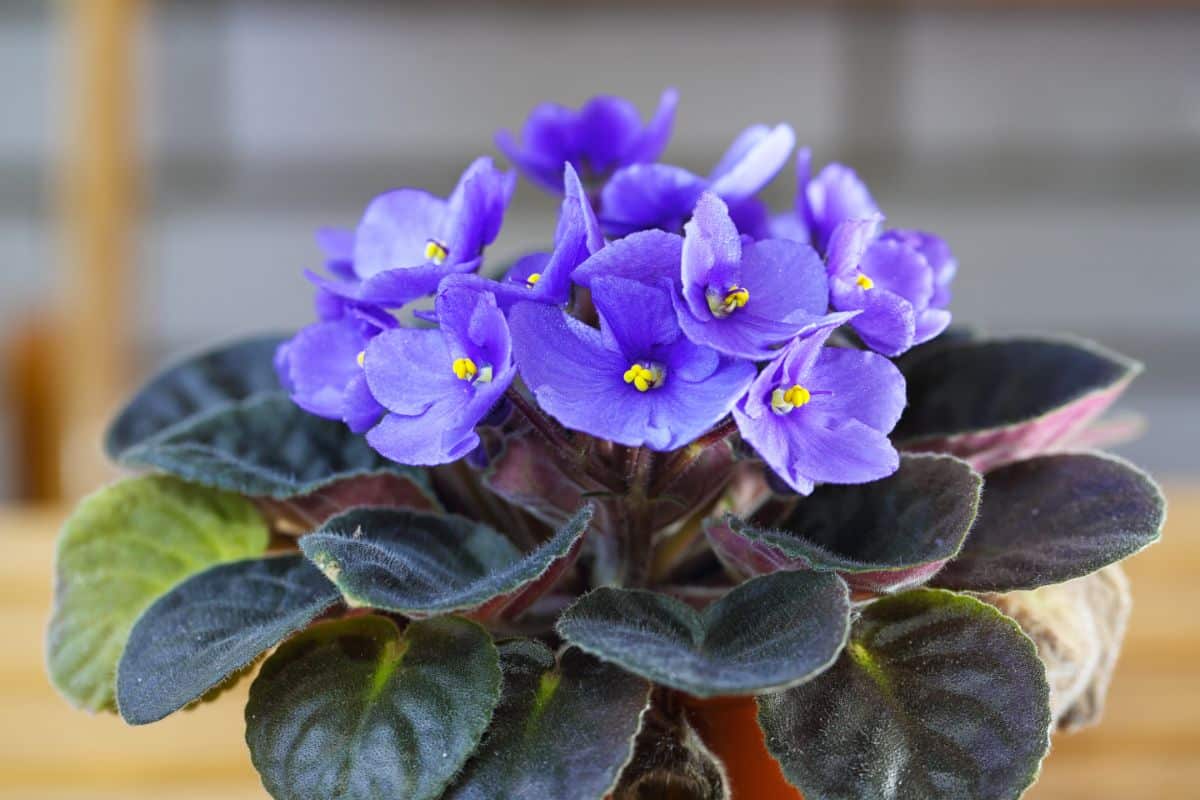
| Plant name: | African violet |
| Lighting requirements: | Bright, indirect light |
| Watering requirements: | Moderate |
| Size: | 16” high, 6” high (miniature varieties) |
| Other growing notes: | Getting water on African violet leaves can cause leaf spotting and other issues. |
There are so many reasons why people love African violets. They are low-maintenance plants with plenty of wow factor thanks to their brightly colored flowers that come in pinks, purples, and white. And, of course, these delightful little houseplants also have wonderfully furry leaves for all the texture you could want.
African violets tend to stay small (usually under 16” high), so they are well-suited for small spaces and windowsill gardens. They even come in mini sizes too that are even more petite and perfect for terrariums. Just remember that African violets don’t like getting their leaves wet, so always water from the bottom.
Because of their watering requirements, African violets do particularly well in self-watering planters. And, happily, for houseplant keepers, there are lots of charming African violet planters to choose from!
4. Iron cross begonia (Begonia masoniana)

| Plant name: | Iron cross begonia |
| Lighting requirements: | Bright, indirect light |
| Watering requirements: | Moderate |
| Size: | 18 to 24” high |
| Other growing notes: | Iron cross begonias do produce flowers, but they are smaller blooms than many other begonia species. |
Begonias are the type of plant you can’t have just one of. With lots of highly patterned and colorful leaves, it can be hard to choose which begonia is your favorite; however, if you like lots of texture and furry leaves, you have to try the iron cross begonia.
Named after its highly contrasting leaves, iron cross begonia leaves are patterned with a dark marking at the center, which is said to resemble a Crusaders’ cross. Leaves are dotted with small hairs, too, that are not as soft as some of the other furry plants on this list, but they still make fine textural plants. Like other begonias, iron cross begonias prefer bright, indirect light and regular watering.
5. Piggyback plant (Tolmiea menziesii)
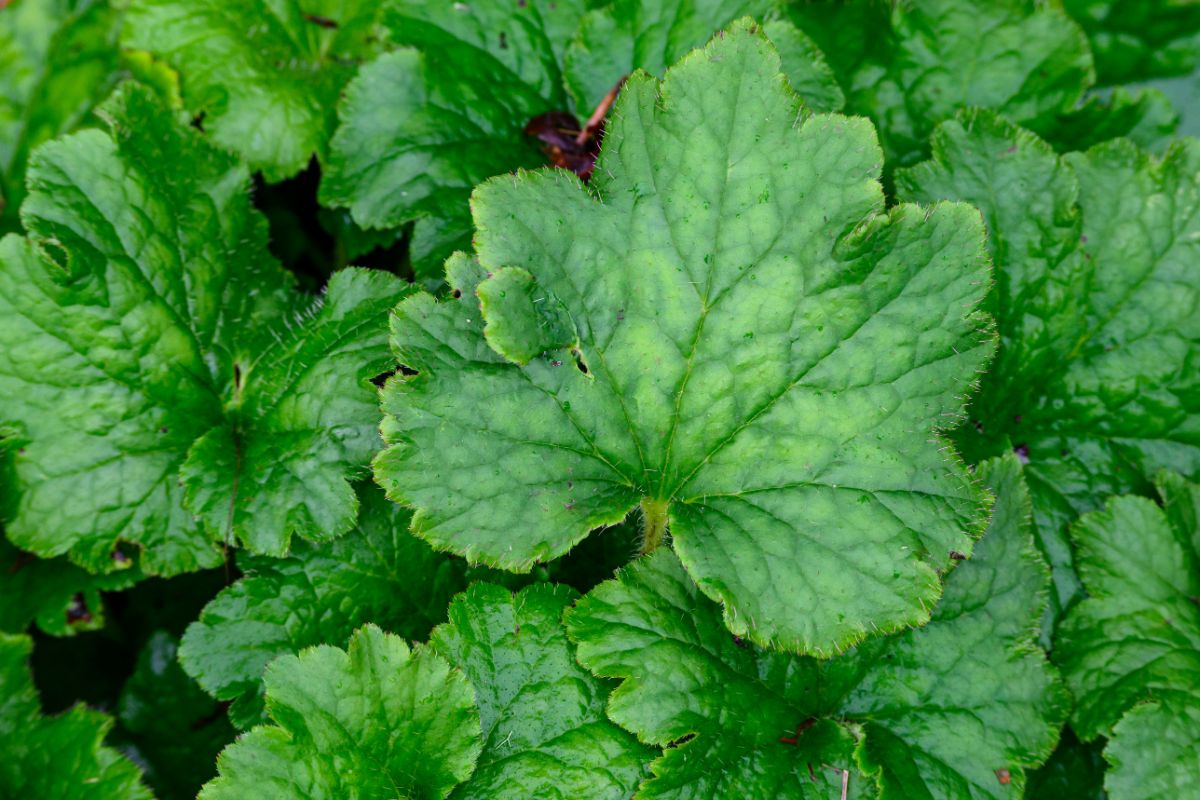
| Plant name: | Piggyback plant |
| Lighting requirements: | Bright, indirect light |
| Watering requirements: | High |
| Size: | 1 to 3’ high |
| Other growing notes: | A Piggyback plant requires at least 50% humidity, so add a humidifier or pebble tray to your setup. |
The Piggyback plant is named for its unusual growth habit, in that new leaves sprout from the base of older, more mature leaves in a “piggyback” fashion. This makes the piggyback plant quite a unique houseplant to grow, as does the fact that this plant is native to the western United States. Since most houseplants come from tropical regions, it is less common to find houseplants from temperate climates.
Because it is native to North America, piggyback plants prefer to grow in cooler locations, but they do like lots of humidity. This can make them a bit tricky to keep happy indoors, but just keep in mind that they have similar growth requirements to ferns. That means that if you have a steamy bathroom, your piggyback plant will likely adore the extra humidity.
White piggyback plants can be kept as tabletop specimens; their cascading growth habit makes them ideal for hanging baskets too. And don’t forget, these charming plants have fuzzy, bright green leaves as well!
6. Lamb’s ear (Stachys byzantine)
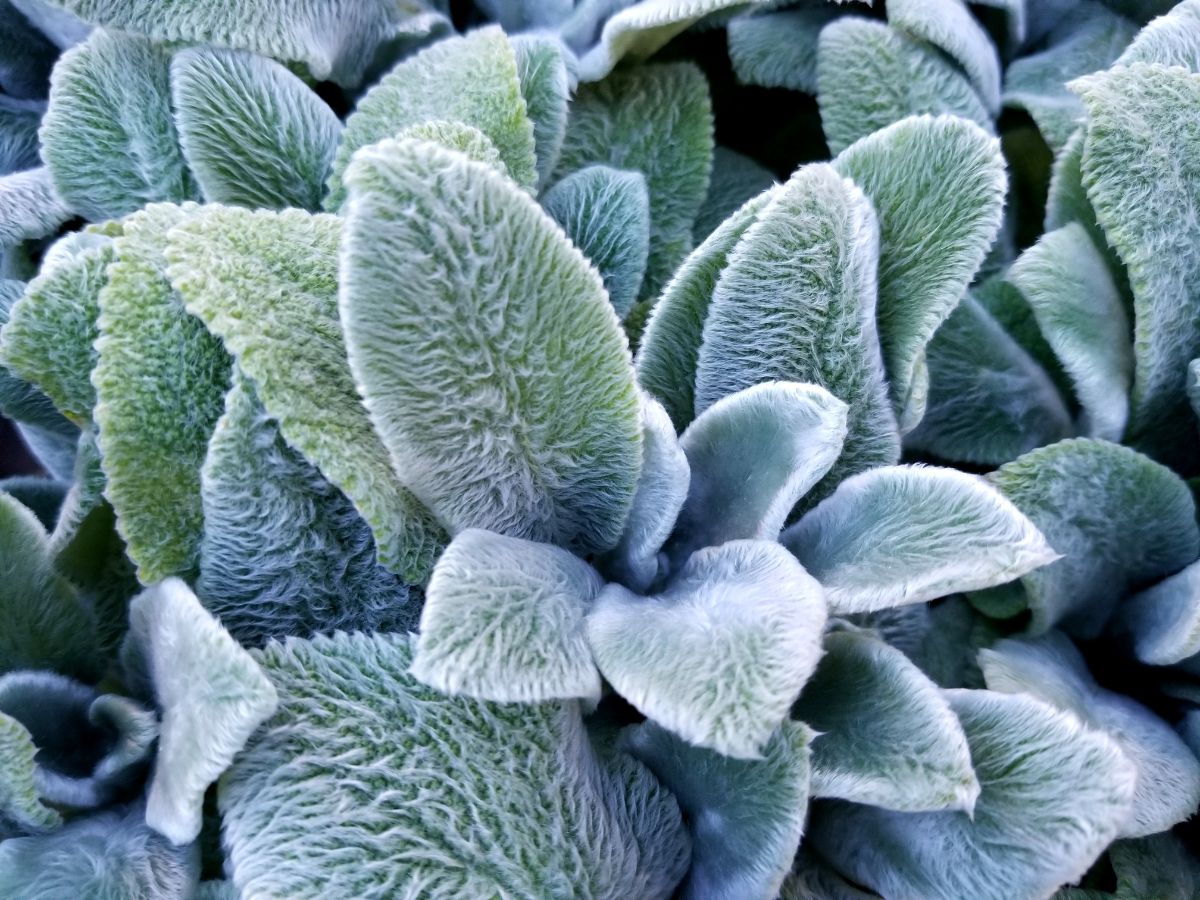
| Plant name: | Lamb’s ear |
| Lighting requirements: | Bright light |
| Watering requirements: | Moderate to low |
| Size: | 8 to 10” high |
| Other growing notes: | Lamb’s ears are a relative of mints and can spread aggressively when grown outdoors. |
Lamb’s ear is most commonly grown as an outdoor plant, where its low growing habit and dense leaves make it a wonderful groundcover choice. However, if you love fuzzy, textural leaves, lamb’s ear can be grown indoors too. And, because this plant tends to spread like crazy, keeping your lamb’s ear in a pot can ensure your plant maintains a tidier form.
The trick to keeping a lamb’s ear happy indoors is to provide it with lots of bright light. If you don’t have a brightly lit window, a grow light is a must. Other than that, lamb’s ears are quite easy to keep and don’t need lots of water, as too much water can cause root rot.
7. Pussy ears (Cyanotis somaliensis)
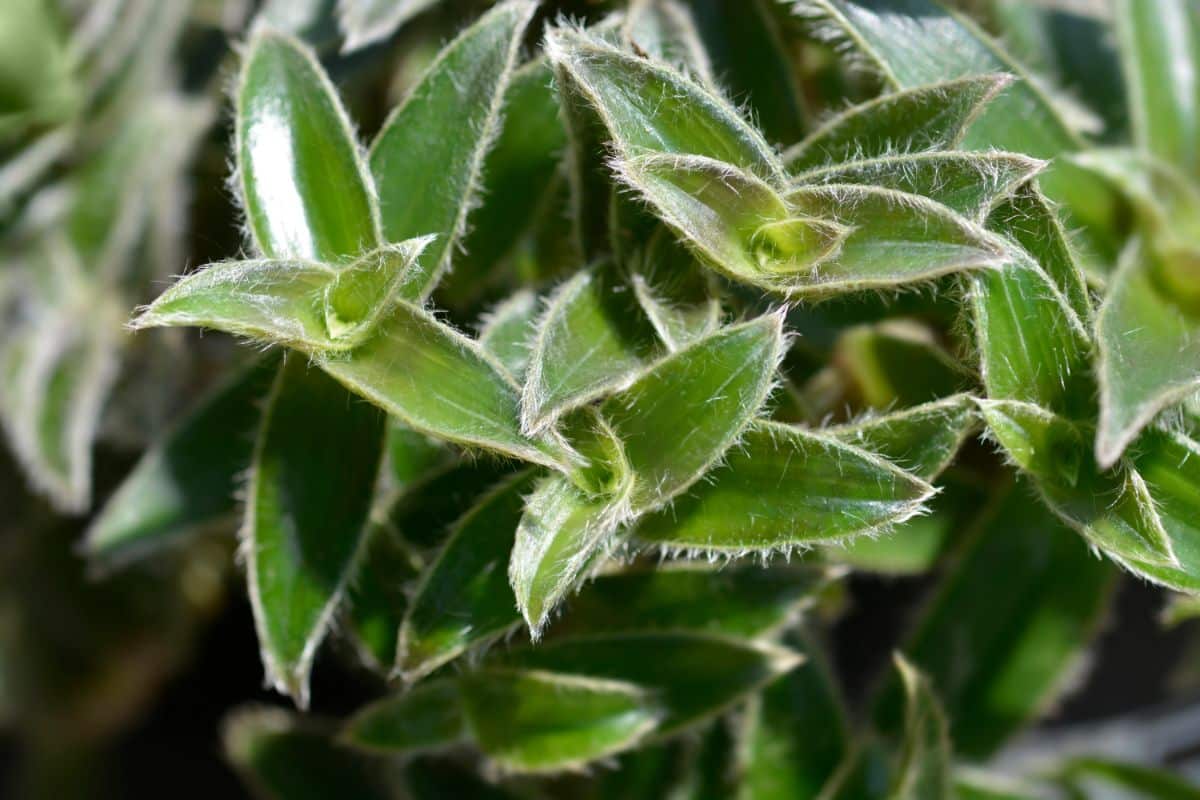
| Plant name: | Pussy ears |
| Lighting requirements: | Bright to medium light |
| Watering requirements: | Moderate to low |
| Size: | 6 to 18” high |
| Other growing notes: | Providing your plant with brighter light can cause your plant to produce more purple tones. |
Pussy ears may look a bit like plants in the tradescantia family, but it’s actually a totally different plant species. A type of succulent, pussy ears is drought tolerant and prefers minimal watering. It also grows best in bright, indirect light, and the amount of light it receives can alter the coloration of its lance-shaped leaves.
Pussy ear leaves range in color from bright green to purple, and they are coated in white bristles. Growing about 12” high, this plant has a slightly cascading growth habit, and it shows well in hanging baskets. While this plant may be difficult to come by, it is worth the hunt, and it can be easily propagated with stem cuttings to share with friends.
8. Chenille plant (Acalypha hispida)
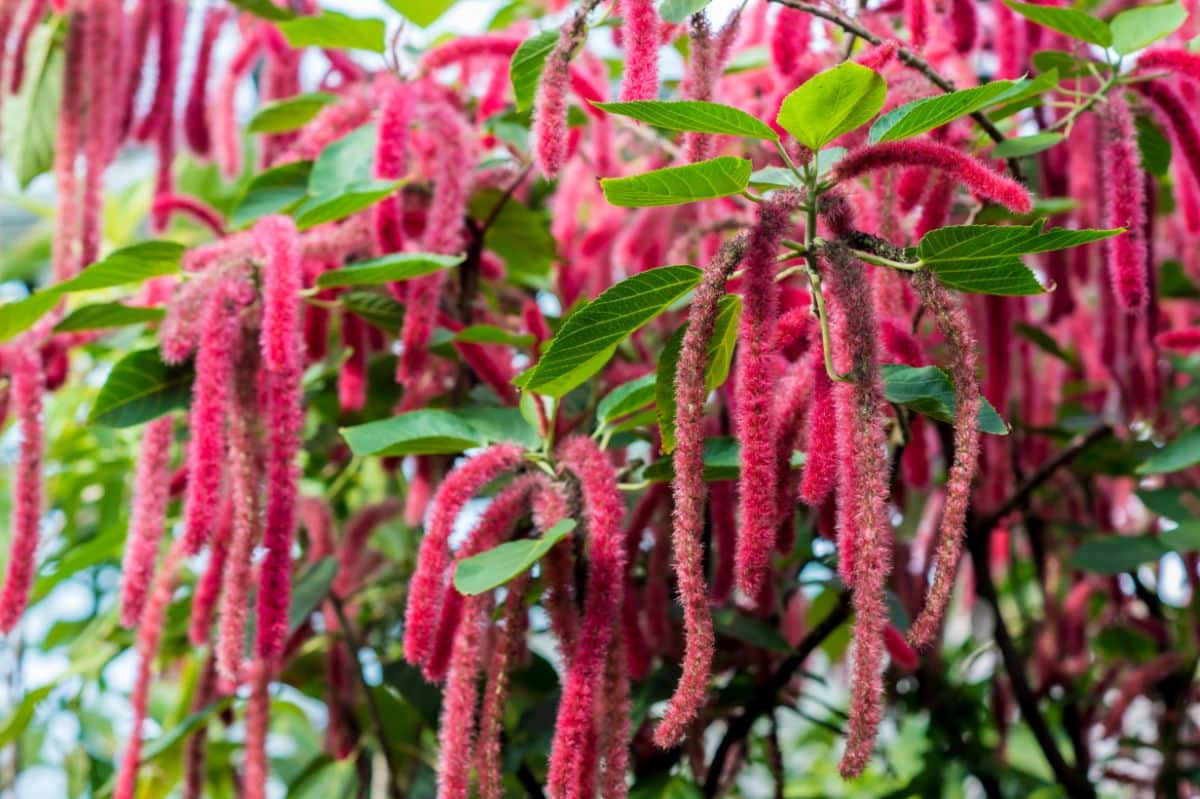
| Plant name: | Chenille plant |
| Lighting requirements: | Bright light |
| Watering requirements: | High to moderate |
| Size: | Up to 3’ high when planted in containers |
| Other growing notes: | Chenille plants flower in the springtime. |
Another plant that is often kept outside, chenille plants, can be grown as houseplants, too, for year-round color and interest. Female chenille plants flower throughout the year with bright crimson, fluffy flowers that cascade gently from the plant’s stems. Combined with its vibrant, heart-shaped leaves, the chenille plant creates a true spectacle when it blooms and looks particularly stunning in a hanging basket display.
Requiring lots of bright sun and consistently moist soil, the chenille plant can be a bit trickier to keep happy than some of the other plants on this list. But, if you’re up to the challenge, it will reward you. Just remember to prune away spent blooms frequently, as this will encourage your plant to flower more.
9. Old man cactus (Cephalocereus senilis)
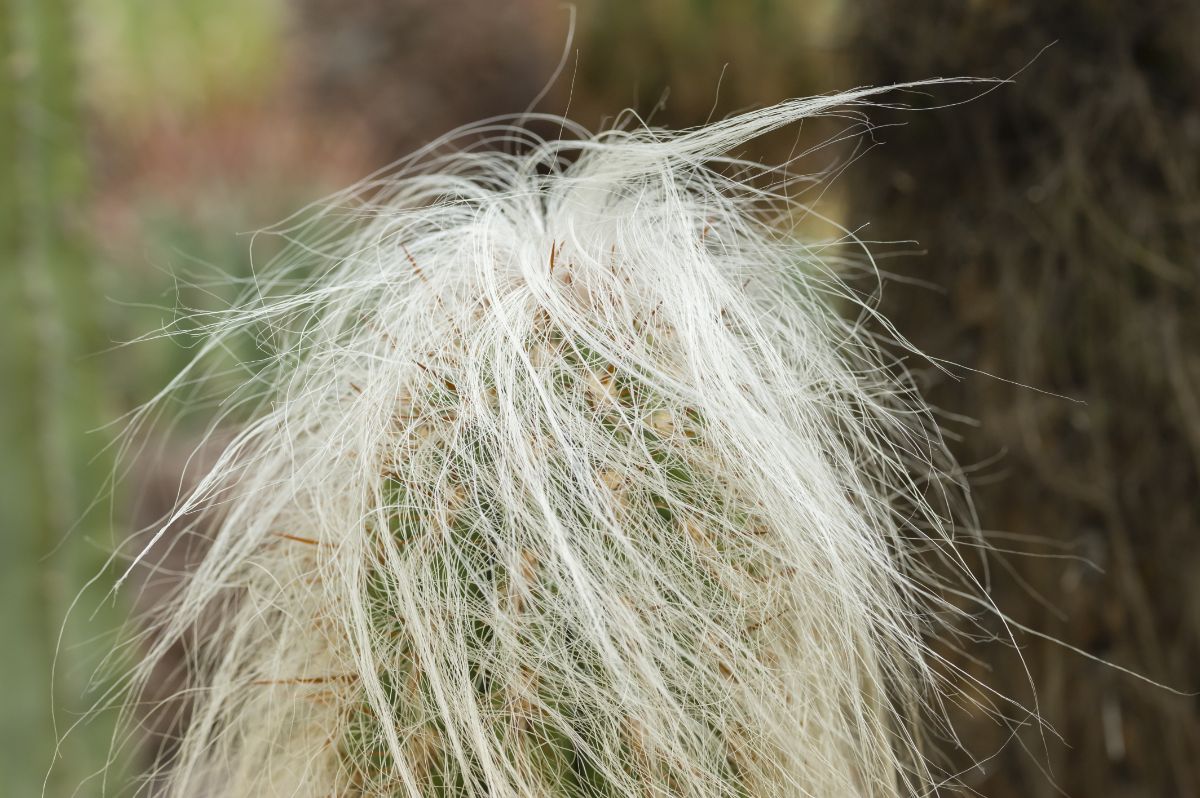
| Plant name: | Old man cactus |
| Lighting requirements: | Bright light |
| Watering requirements: | Low |
| Size: | 3’ high |
| Other growing notes: | Like other cacti, old man cacti can live a long time – up to 100 years! |
When you think of cacti, you generally don’t think of furry plants, but old man cactus offers something different. Whereas most cacti are covered in sharp spines, old man cactus have evolved modified spines that have the appearance of soft white hairs. But don’t be fooled: some cacti still have spines underneath all that white fuzz.
Like other cactus species, the old man cactus has minimal care requirements and needs very little water. Overwatering your plant can cause root rot and the cactus to collapse, so only water your plant about once a month or even less. And be sure to place your cactus in a brightly lit window as this plant does like lots of light!
10. Bear paw jade (Cotyledon tomentosa)
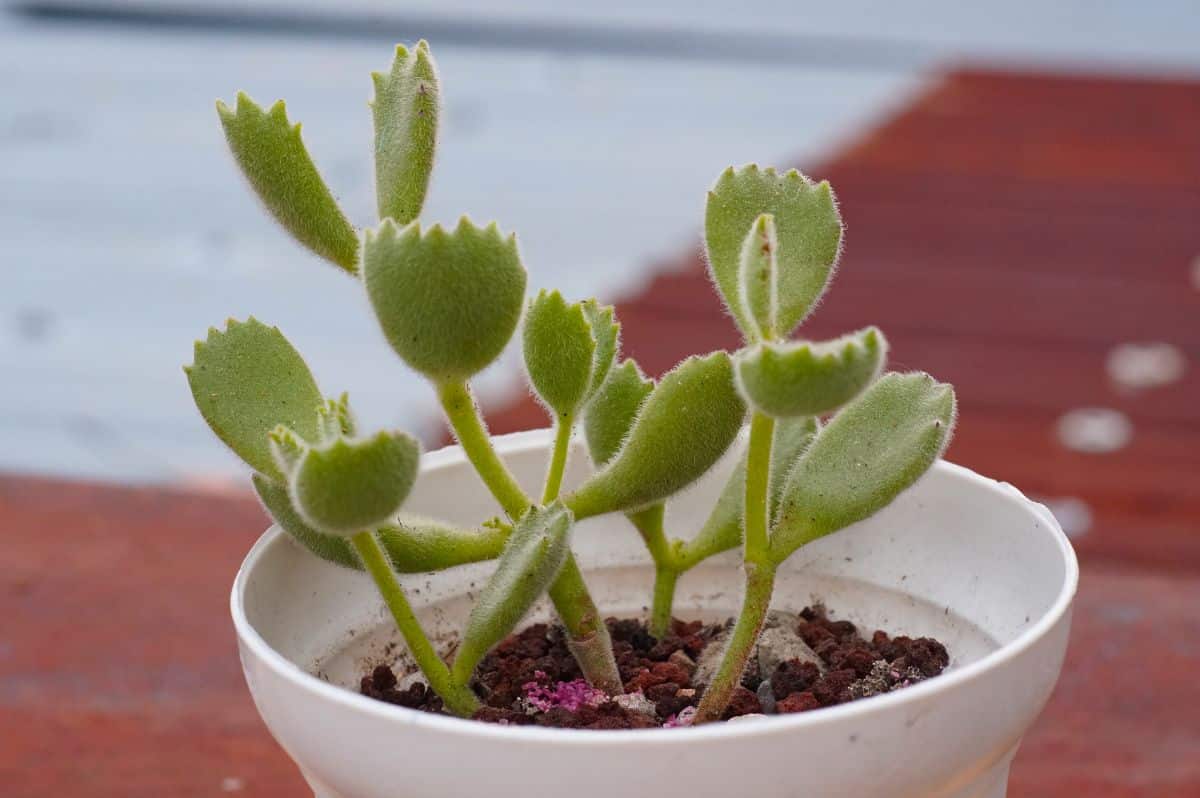
| Plant name: | Bear paw jade |
| Lighting requirements: | Bright light |
| Watering requirements: | Low |
| Size: | 6” high |
| Other growing notes: | Increasing light can encourage your plant to develop more color in its leaves. |
Bear paw jades are adorable succulents, so it’s no wonder that they are a favorite houseplant among children. Plump, bright green leaves look a bit like a bear’s paws, and the effect is only increased by the serrated edge on the leaves' upper margins, which resemble a bear’s sharp claws. And, like a bear, this succulent is also covered in soft white hairs and is super soft to the touch.
Growing up to 6” high, this plant stays small, so it will work well in small spaces or on a windowsill garden. It also loves lots of bright light, so try orienting it in a brightly lit window and water sparingly to prevent root rot. Bear paw jades can be easily propagated with stem cuttings, but you can grow more plants from leaf cuttings too.
11. Pussy willow (Salix discolor)
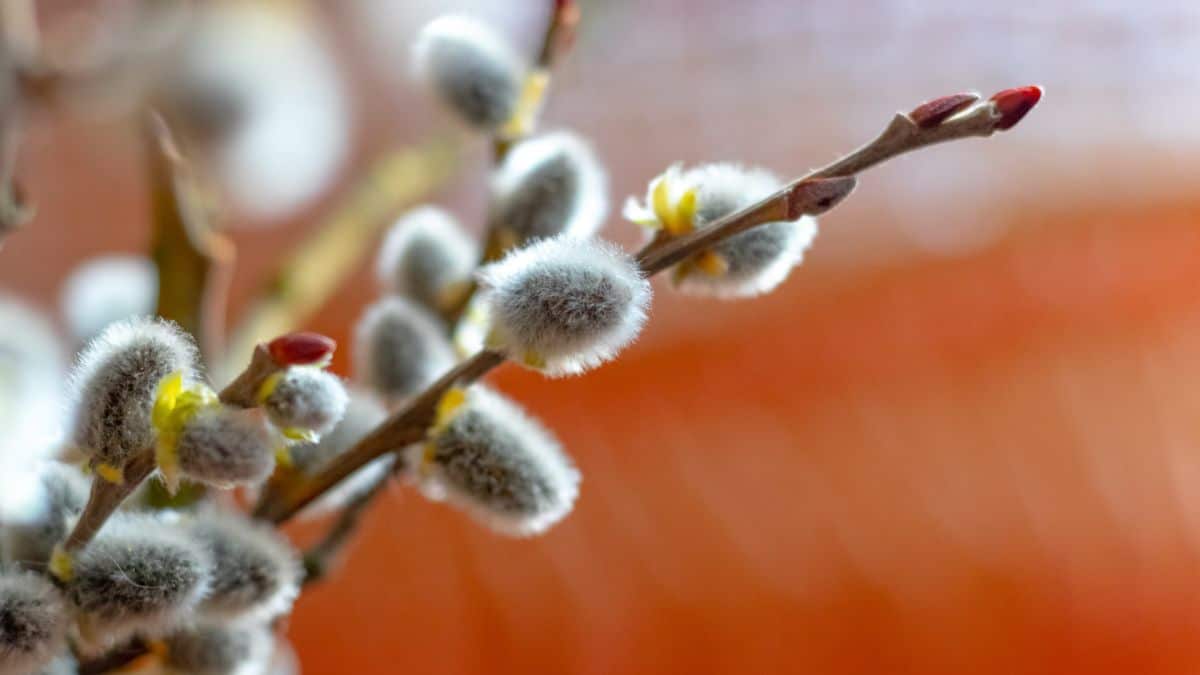
| Plant name: | Pussy willow |
| Lighting requirements: | Bright light |
| Watering requirements: | High to moderate |
| Size: | 6 to 15’ high, although plants stay smaller when grown in pots |
| Other growing notes: | Pussy willow’s characteristic buds appear in late winter to spring, depending on your growing location. |
Pussy willows are generally kept as outdoor plants; however, they can be grown in pots indoors with little know-how. Specifically, pussy willows are not typical houseplants, and they require a winter dormancy period to jumpstart their characteristic fuzzy springtime catkins.
To encourage your pussy willow to flower, you can plant your willow outdoors in late fall or you can move it into an unheated garage or shed. Leave your plant in this state of dormancy for about 3 months, and then move it back indoors in spring. This will trick your plant into thinking winter has passed, and it will begin to bloom.
12. Mexican firecracker (Echeveria setosa)

| Plant name: | Mexican firecracker |
| Lighting requirements: | Bright light |
| Watering requirements: | Low |
| Size: | 12” high |
| Other growing notes: | If your plant appears to be getting leggy, try cutting off the spindly growth and rooting your succulent in the soil. |
A native of Mexico, the Mexican firecracker is a type of echeveria and is a cheery plant to keep. With a tight, rosette form, this plant stays quite small and is coated in white bristles that catch the light beautifully. When mature, expect your echeveria to bloom a brightly colored, orange-red flower atop a long and slender stem.
Like other succulents, the Mexican firecracker needs minimal watering and a well-draining potting mix that’s suitable for cacti and succulents. It also grows best in full sun, but it can adapt to partial shade too. Just keep in mind that lighting can change this plant’s coloration slightly, with brighter light producing more reddish tips on the plant’s leaves.
13. Green goddess (Echeveria haageana)
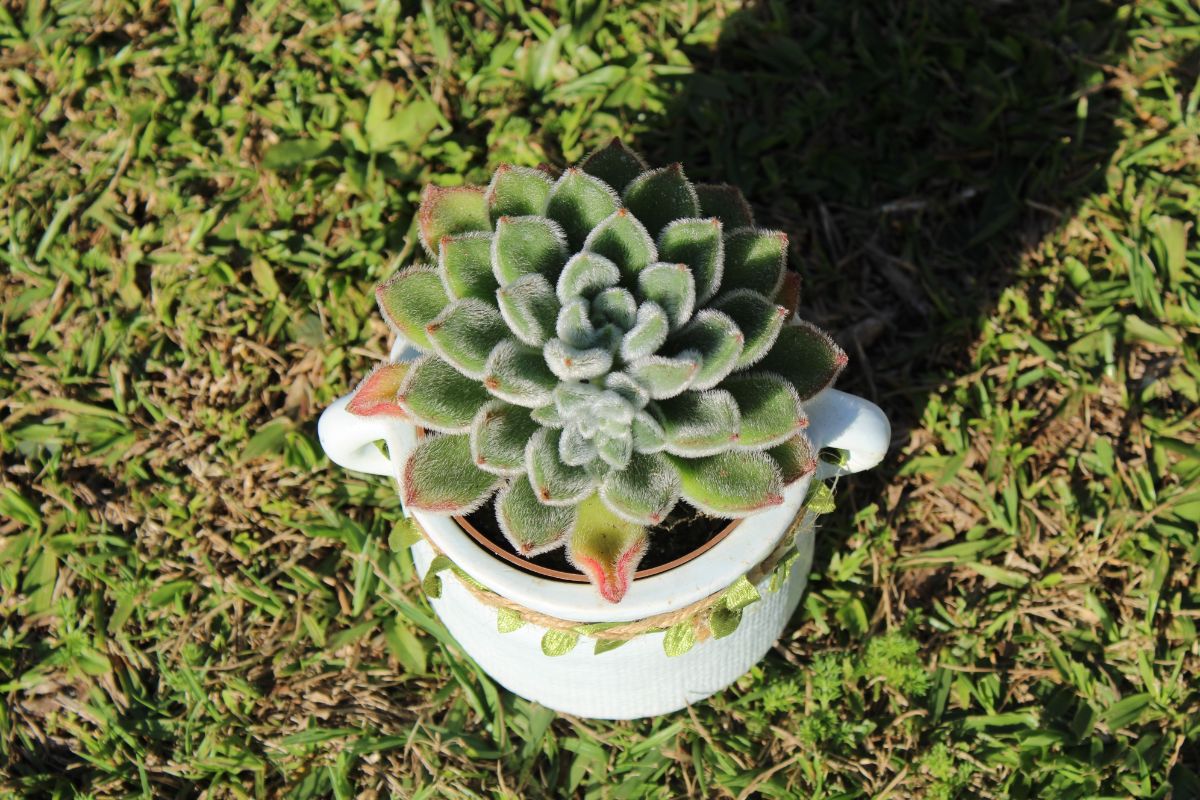
| Plant name: | Green goddess |
| Lighting requirements: | Bright light |
| Watering requirements: | Low |
| Size: | 5” high |
| Other growing notes: | Like other echeveria species, this plant is pet safe. |
With a gorgeous mint green color, the green goddess is a showstopping plant that will brighten up any collection. And if you like soft leaves, it’s got those too. In fact, its chunky and slightly tapering leaves are coated in short cilia, which give the plant a silky smooth feel.
Like other succulents, green goddess prefers brighter light and can stretch and get leggy in poorly lit homes. Once mature, this plant will produce pretty, golden-orange, bell-shaped flowers in late winter to early spring. And it readily reproduces itself by sprouting offsets at the plant’s base too.
14. Felted pepperface (Peperomia incana)
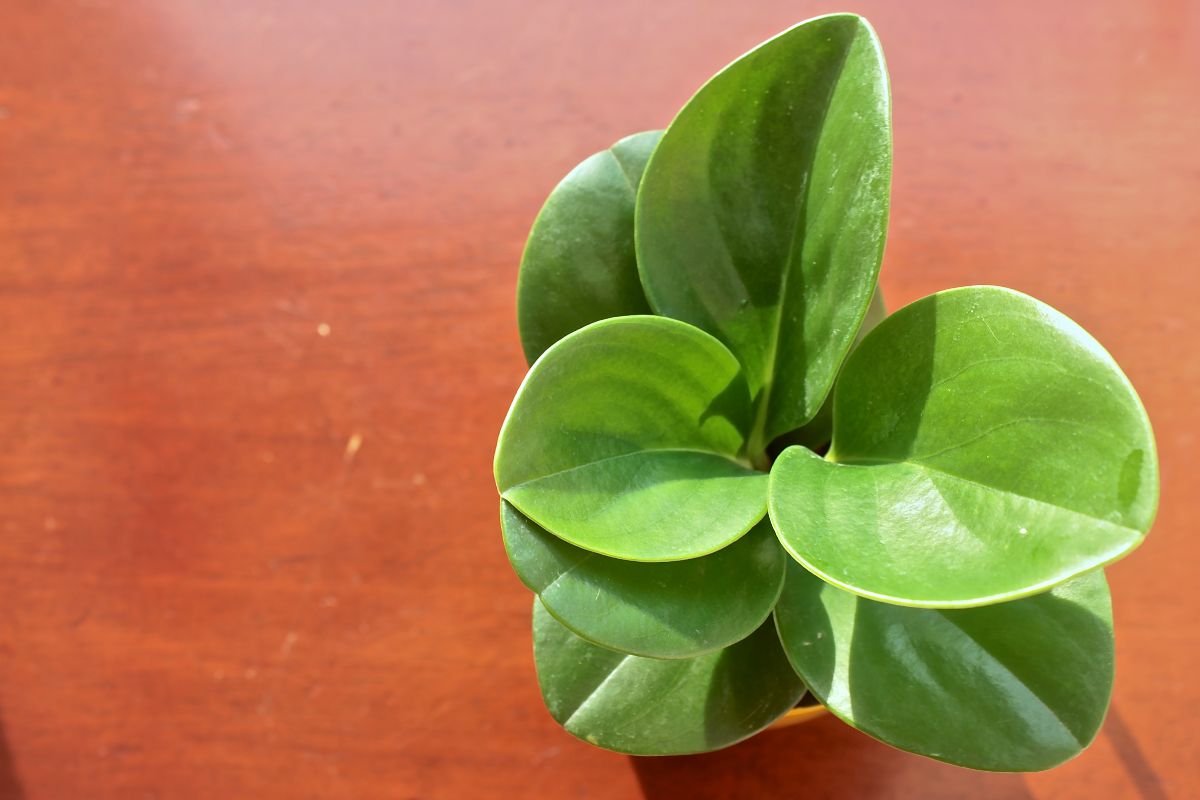
| Plant name: | Felted pepperface |
| Lighting requirements: | Bright to low light |
| Watering requirements: | Moderate |
| Size: | 12” high |
| Other growing notes: | Mature plants will bloom long and slender white flowers throughout summer. |
Also known as fuzzy pigface, this Brazilian native boasts pretty, heart-shaped leaves that are coated in a soft, silvery fuzz. That furry coating is intended to protect the plant from bright sun and sunscald and makes the plant more drought resistant overall.
A slow-growing plant, felted pepperface doesn’t have high maintenance needs; however, you can try pinching back the growth from time to time to encourage your plant to grow a bit bushier. If well-tended, your pepperface may produce insignificant white flowers that are fragrance-free. However, most keepers prize this plant solely for its fuzzy leaves, and any flowers that bloom are simply an added bonus.
15. Pickle plant (Delosperma echinatum)
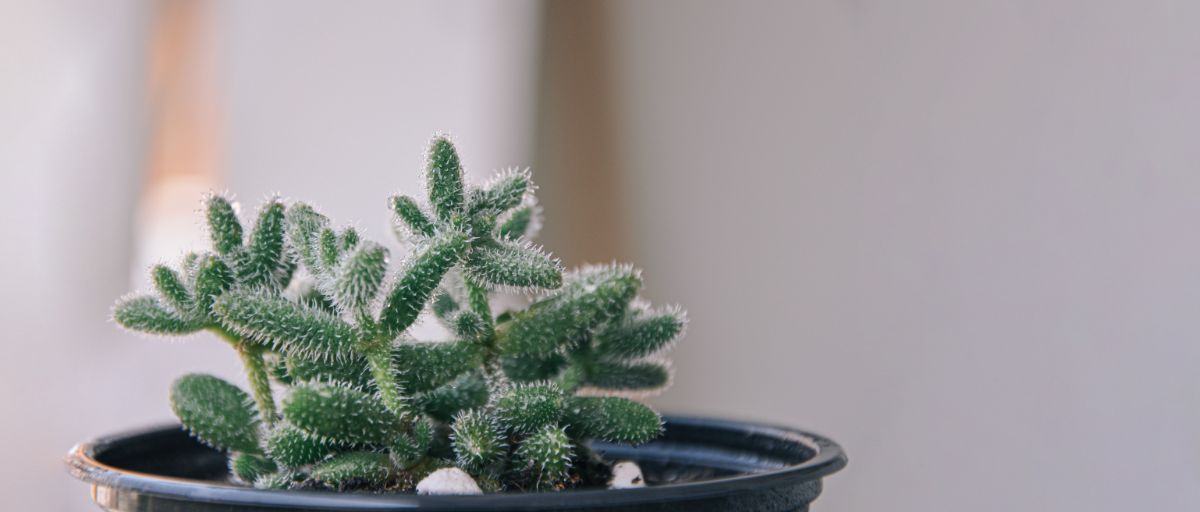
| Plant name: | Pickle plant |
| Lighting requirements: | Bright, indirect light |
| Watering requirements: | Low |
| Size: | 18” high |
| Other growing notes: | Pickle plants are native to South Africa. |
The pickle plant is a playful houseplant species with chubby, rounded leaves that are covered in soft, spiny-looking hairs. When mature, the plant will also flower a delicate, golden-yellow bloom that looks a bit like a dandelion. The draping growth habit makes the pickle plant appropriate for both tabletop planters and hanging basket displays, depending on your growing space.
You may have a little trouble finding this plant, as it is rarely sold at big box stores. Instead, if you’re on the hunt for your own pickle plant, check online, as you’ll likely have better luck there. When mature, pickle plants grow to about 18” in height and can be propagated by both stem and leaf cuttings.
Frequently asked questions
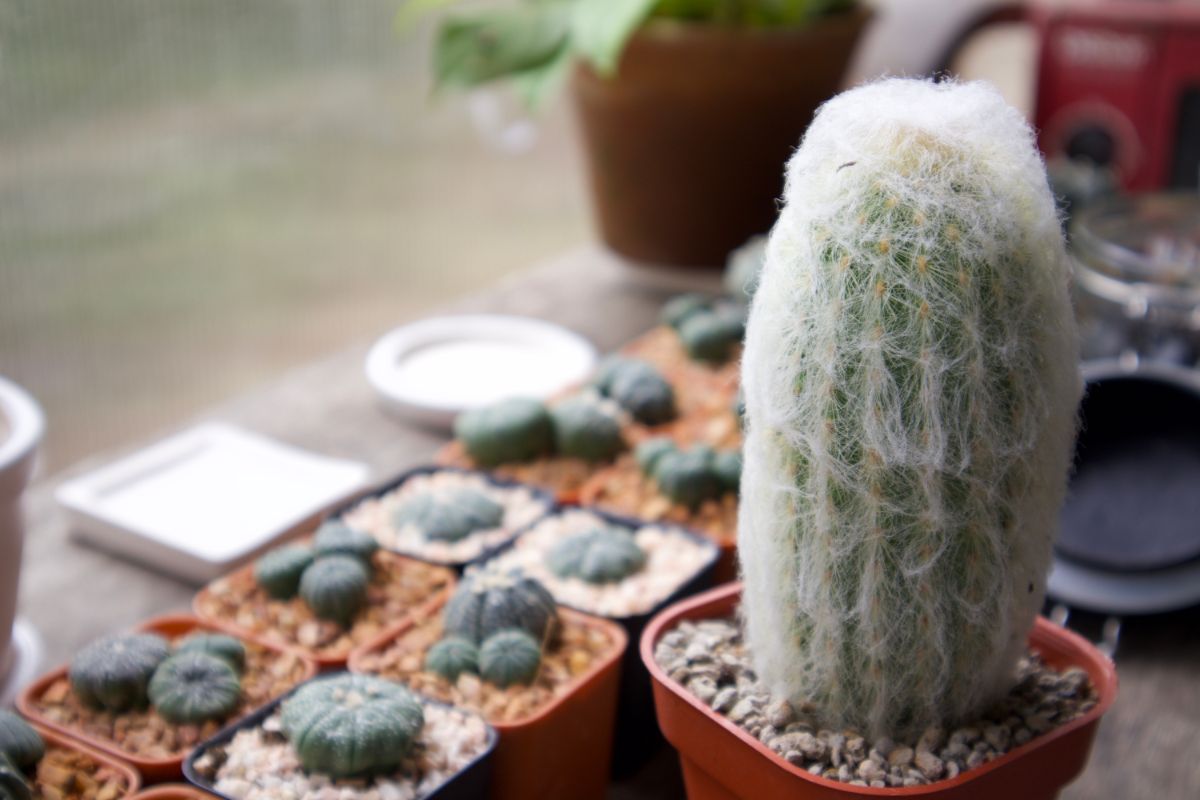
There are many different houseplants with furry leaves; however, some of the most popular include African violets, velvet plants, and panda plants.
Plants develop furry leaves for a number of reasons, but one of the most common is protection. Hairy leaves help to shield plants from too much bright sun and can also deter pest predation in nature.
Several different succulent species have furry leaves. Some of the most popular include panda plants, bear paw jades, and Mexican firecrackers.
While a bit of water on your violets’ leaves won’t kill them, it can cause unsightly water markings and other issues. For this reason, whenever possible, water your African violet only from the bottom and avoid getting water on your plant’s leaves.
If you get your plant leaves wet, try to blot up as much moisture as possible with a paper towel. After that, move your plant out of bright light or direct sun for several hours or even overnight to allow the water droplets to dry completely. This will prevent any damage to your plant’s leaves.
Summary

From the purple passion plant to the felted pepperface, there are a surprising number of adorable and furry plants to add to your houseplant collection. We hope you’ve found inspiration on fuzzy plants to keep, but if you’re still on the hunt for your new favorite houseplant, check out our list of the best air-purifying houseplants for more exciting species to try.

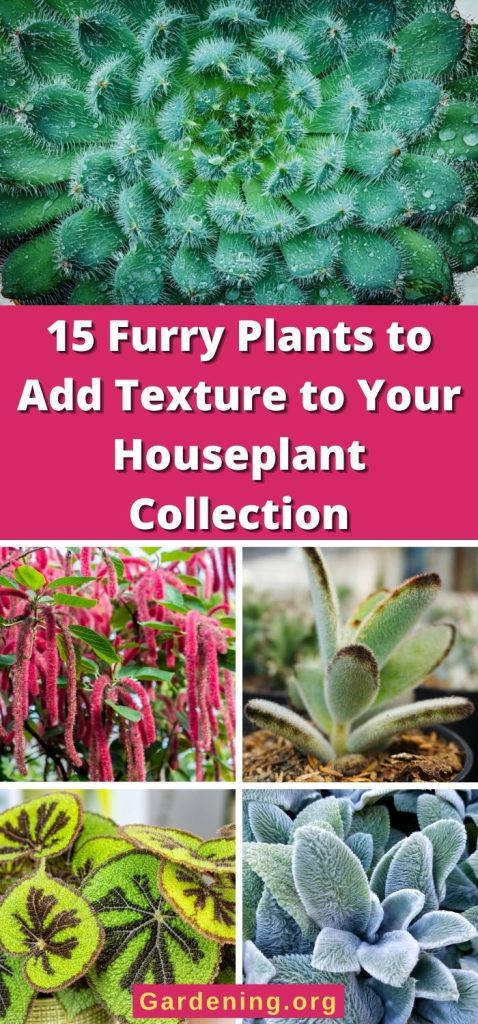

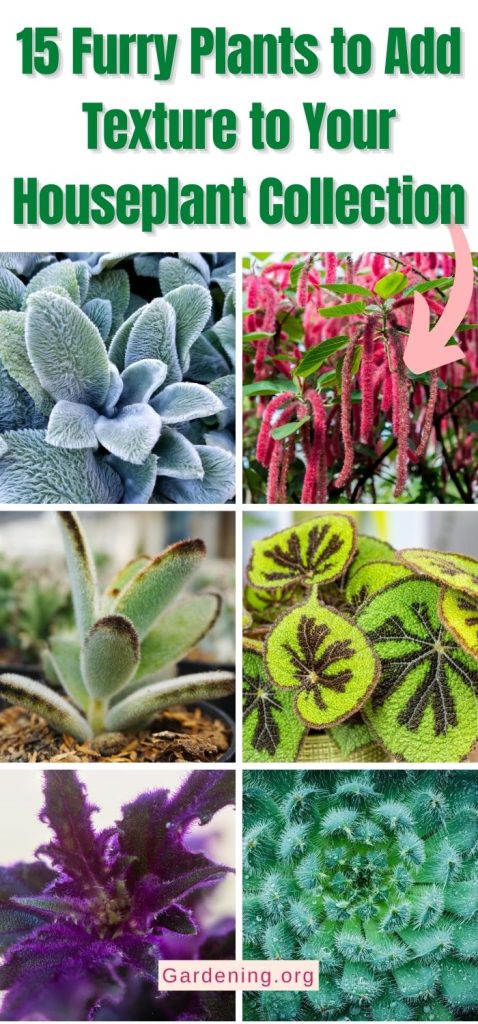
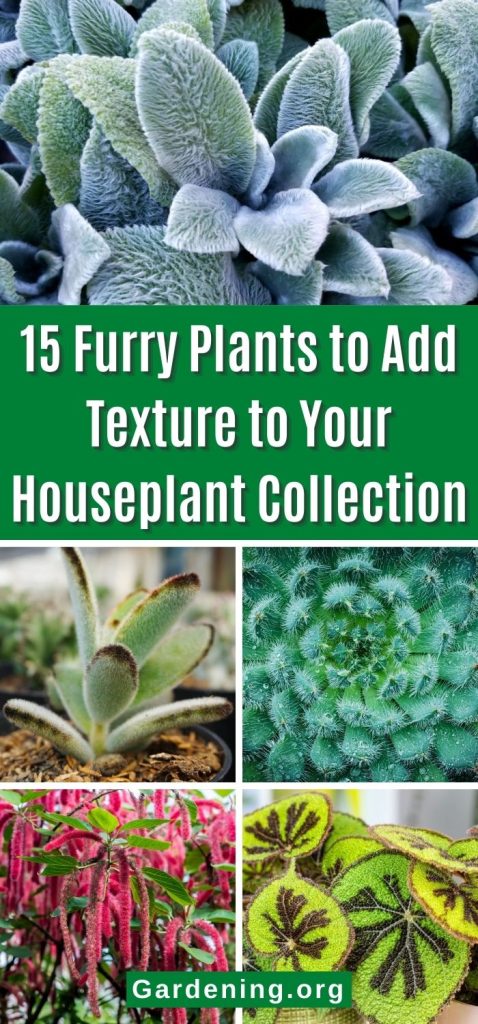
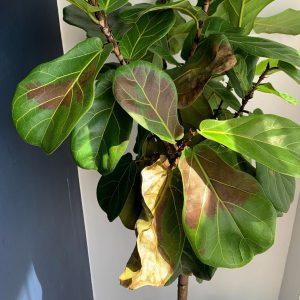
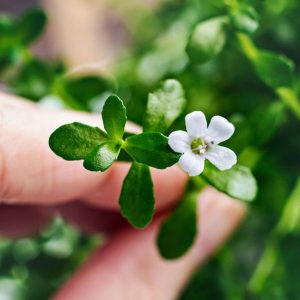
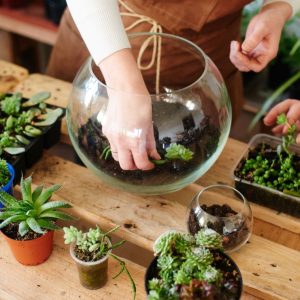

Leave a Reply